A module - JUG Saxony Day
Werbung
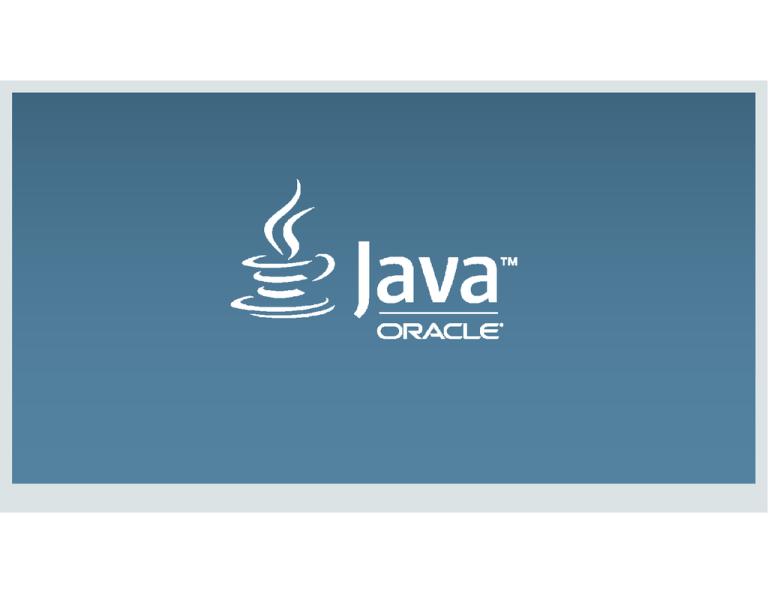
Safe Harbor Statement
The preceding is intended to outline our general product direction. It is intended for
information purposes only, and may not be incorporated into any contract. It is not a
commitment to deliver any material, code, or functionality, and should not be relied upon
in making purchasing decisions. The development, release, and timing of any features or
functionality described for Oracle’s products remains at the sole discretion of Oracle.
Copyright © 2016, Oracle and/or its affiliates. All rights reserved. |
2
Title9Slide
withmodulare
JDK
und die
Java FY15 Jigsaw
Theme
Plattform
Subtitle
Wolfgang
Weigend
Presenter’s Name
Sen.
Leitender
Presenter’s
Title Systemberater
Organization,
Divisionand
or Business
Unit
Java
Technology
Architecture
Month 00, 2014
Note: The speaker notes for this slide
include detailed instructions on how to reuse
this Title Slide in another presentation.
Tip! Remember to remove this text box.
Copyright
© 2014,
Oracle
and/or
its affiliates.
rights
reserved.|
Copyright
© 2016,
Oracle
and/or
its affiliates.
AllAll
rights
reserved.
Agenda
1
JDK 9 Status
2
Modularity
3
Jigsaw und die Werkzeuge
4
Participation
5
Ausblick und Zusammenfassung
Copyright © 2016, Oracle and/or its affiliates. All rights reserved. |
4
JDK 9 Status
http://openjdk.java.net/projects/jdk9/
• The goal of this Project is to produce an open-source reference implementation of the
Java SE 9 Platform, to be defined by a forthcoming JSR in the Java Community Process.
• The schedule and features of this release are proposed and tracked via the JEP Process,
as amended by the JEP 2.0 proposal.
• Schedule (proposed)
2016/05/26
Feature Complete
2016/12/22
Feature Extension Complete
2017/01/05
Rampdown Start
2017/02/09
All Tests Run
2017/02/16
Zero Bug Bounce
2017/03/16
Rampdown Phase 2
2017/07/06
Final Release Candidate
2017/07/27
General Availability
Copyright © 2016, Oracle and/or its affiliates. All rights reserved. |
5
JDK 9 Status – JEP’s targeted to JDK 9, so far 85
http://openjdk.java.net/projects/jdk9/
102: Process API Updates
110: HTTP 2 Client
143: Improve Contended Locking
158: Unified JVM Logging
165: Compiler Control
193: Variable Handles
197: Segmented Code Cache
199: Smart Java Compilation, Phase Two
200: The Modular JDK
201: Modular Source Code
211: Elide Deprecation Warnings on Import Statements
212: Resolve Lint and Doclint Warnings
213: Milling Project Coin
214: Remove GC Combinations Deprecated in JDK 8
215: Tiered Attribution for javac
216: Process Import Statements Correctly
217: Annotations Pipeline 2.0
219: Datagram Transport Layer Security (DTLS)
220: Modular Run-Time Images
221: Simplified Doclet API
222: jshell: The Java Shell (Read-Eval-Print Loop)
223: New Version-String Scheme
224: HTML5 Javadoc
225: Javadoc Search
226: UTF-8 Property Files
227: Unicode 7.0
228: Add More Diagnostic Commands
229: Create PKCS12 Keystores by Default
231: Remove Launch-Time JRE Version Selection
232: Improve Secure Application Performance
233: Generate Run-Time Compiler Tests Automatically
235: Test Class-File Attributes Generated by javac
236: Parser API for Nashorn
237: Linux/AArch64 Port
238: Multi-Release JAR Files
240: Remove the JVM TI hprof Agent
241: Remove the jhat Tool
243: Java-Level JVM Compiler Interface
244: TLS Application-Layer Protocol Negotiation Extension
245: Validate JVM Command-Line Flag Arguments
246: Leverage CPU Instructions for GHASH and RSA
247: Compile for Older Platform Versions
248: Make G1 the Default Garbage Collector
249: OCSP Stapling for TLS
250: Store Interned Strings in CDS Archives
251: Multi-Resolution Images
252: Use CLDR Locale Data by Default
253: Prepare JavaFX UI Controls & CSS APIs for Modularization
254: Compact Strings
255: Merge Selected Xerces 2.11.0 Updates into JAXP
256: BeanInfo Annotations
257: Update JavaFX/Media to Newer Version of GStreamer
258: HarfBuzz Font-Layout Engine
259: Stack-Walking API
260: Encapsulate Most Internal APIs
261: Module System
262: TIFF Image I/O
263: HiDPI Graphics on Windows and Linux
264: Platform Logging API and Service
265: Marlin Graphics Renderer
266: More Concurrency Updates
267: Unicode 8.0
268: XML Catalogs
269: Convenience Factory Methods for Collections
270: Reserved Stack Areas for Critical Sections
271: Unified GC Logging
272: Platform-Specific Desktop Features
273: DRBG-Based SecureRandom Implementations
274: Enhanced Method Handles
275: Modular Java Application Packaging
276: Dynamic Linking of Language-Defined Object Models
277: Enhanced Deprecation
278: Additional Tests for Humongous Objects in G1
279: Improve Test-Failure Troubleshooting
280: Indify String Concatenation
281: HotSpot C++ Unit-Test Framework
282: jlink: The Java Linker
283: Enable GTK 3 on Linux
284: New HotSpot Build System
285: Spin-Wait Hints
287: SHA-3 Hash Algorithms
288: Disable SHA-1 Certificates
289: Deprecate the Applet API
290: Filter Incoming Serialization Data
292: Implement Selected ECMAScript 6 Features in Nashorn
Copyright © 2016, Oracle and/or its affiliates. All rights reserved. |
6
Modularity Landscape
A little bit of background
• Java Platform Module System
– JSR 376
– Targeted for Java SE 9
• Java SE 9
– JSR XXX
– Will own the modularization of the Java SE APIs
• OpenJDK Project Jigsaw
– Reference Implementation for JSR 376
– JEP 200, 201, 220, 260, 261
Copyright © 2016, Oracle and/or its affiliates. All rights reserved. |
7
JSR 376: Java Platform Module System
An approachable yet scalable module system for the Java Platform
• Provide a means for developers and libraries to define their own modules
• Reflection API‘s for module information
• Integration with developer tools (Maven, Gradle, IDE‘s)
• Integration with existing package managers (e.g., RPM)
• Dynamic configuration of module graph (e.g., for Java EE containers)
• Current documents, code, & builds
Requirements
The State of the Module System (design overview)
Initial draft JLS and JVMS changes
Draft API specification (diffs relative to JDK 9)
java.lang.Class
java.lang.ClassLoader
java.lang.reflect.Module
java.lang.module
Issue summary
RI prototype: Source, binary
Copyright © 2016, Oracle and/or its affiliates. All rights reserved. |
8
Projekt Jigsaw
JDK Enhancement Proposal’s (JEP’s)
JSR 376 Java Platform Module System
JEP 200 - The Modular JDK
JEP 201 - Modular Source Code
JEP 220 - Modular Run-Time Images
OpenJDK Jigsaw Early Access builds are available
JDK 9 Early Access with Project Jigsaw, build 136
http://jdk9.java.net/jigsaw
Copyright © 2016, Oracle and/or its affiliates. All rights reserved. |
9
JEP 200: The Modular JDK (1)
Goal: Define a modular structure for the JDK.
• Make minimal assumptions about the module system that will be used to
implement that structure.
• Divide the JDK into a set of modules that can be combined at compile time,
build time, install time, or run time into a variety of configurations including,
but not limited to:
– Configurations corresponding to the full Java SE Platform, the full JRE, and the full JDK;
– Configurations roughly equivalent in content to each of the Compact Profiles defined
in Java SE 8; and
– Custom configurations which contain only a specified set of modules and the modules
transitively required by those modules.
Copyright © 2016, Oracle and/or its affiliates. All rights reserved. |
10
JEP 200: The Modular JDK (2)
Module System Assumptions: A module …
• can contain class files, resources, and related native and configuration files.
• has a name.
• can depend, by module name, upon one or more other modules.
• can export all of the public types in one or more of the API packages that it
contains, making them available to code in other modules depending on it
• can restrict, by module name, the set of modules to which the public types
in one or more of its API packages are exported. (sharing internal interface)
• can re-export all of the public types that are exported by one or more of
the modules upon which it depends. (support refactoring & aggregation)
Copyright © 2016, Oracle and/or its affiliates. All rights reserved. |
11
JEP 200: The Modular JDK (3)
Design Principles
• Standard modules, whose specifications are governed by the JCP, must
have names starting with the string "java.".
• All other modules are merely part of the JDK, and must have names
starting with the string "jdk.".
• If a module exports a type that contains a public or protected member
that, in turn, refers to a type from some other module then the first
module must re-export the public types of the second. This ensures that
method-invocation chaining works in the obvious way.
• Additional principles in JEP 200 text to ensure that code which depends
only upon Java SE modules will depend only upon standard Java SE types.
Copyright © 2016, Oracle and/or its affiliates. All rights reserved. |
12
JEP 200: The Modular JDK (4)
Module Graph
Copyright © 2016, Oracle and/or its affiliates. All rights reserved. |
13
Module System Goals
Overall View
• Reliable configuration
– replace the brittle, error-prone class-path mechanism with a means for program
components to declare explicit dependences upon one another
• Strong encapsulation
– allow a component to declare which of its public types are accessible to other
components, and which are not.
• Addressing these goals would enable further benefits:
– A scalable platform
– Greater platform integrity
– Improved performance
Copyright © 2016, Oracle and/or its affiliates. All rights reserved. |
14
Modules
A fundamental new kind of Java component
• A module is a named, self-describing collection of code & data
– Code is organized as a set of packages containing types
• It declares which other modules it requires in order to be compiled and run
• It declares which of its packages it exports.
• Module system locates modules
– Ensures code in a module can only refer to types in modules upon which it depends
– The access-control mechanisms of the Java language and the Java virtual machine
prevent code from accessing types in packages that are not exported by their defining
modules.
Copyright © 2016, Oracle and/or its affiliates. All rights reserved. |
15
Module declarations (1)
A new construct of the Java programming language
• The simplest possible module declaration just specifies the name of its
module:
module com.foo.bar { }
Copyright © 2016, Oracle and/or its affiliates. All rights reserved. |
16
Module declarations (2)
A new construct of the Java programming language
• requires clauses can be added to declare that the module depends, by
name, upon some other modules, at both compile time and run time:
module com.foo.bar {
requires com.foo.baz;
}
Copyright © 2016, Oracle and/or its affiliates. All rights reserved. |
17
Module declarations (3)
A new construct of the Java programming language
• exports clauses can be added to declare that the module makes all, and only,
the public types in some packages available for use by other modules:
module com.foo.bar {
requires com.foo.baz;
exports com.foo.bar.alpha;
exports com.foo.bar.beta;
}
– If a module’s declaration contains no exports clauses then it will not export any types
at all to any other modules.
Copyright © 2016, Oracle and/or its affiliates. All rights reserved. |
18
Module declarations (4)
A new construct of the Java programming language
• The source code for a module declaration is, by convention, placed in a file
named module-info.java at the root of the module’s source-file hierarchy.
• The source files for the com.foo.bar module, e.g., might include:
module-info.java
com/foo/bar/alpha/AlphaFactory.java
com/foo/bar/alpha/Alpha.java
...
• A module declaration is compiled, by convention, into a file
named module-info.class, placed similarly in the class-file output directory.
Copyright © 2016, Oracle and/or its affiliates. All rights reserved. |
19
Module declarations (5)
A new construct of the Java programming language
• Module names, like package names, must not conflict.
– recommended way to name a module is to use the reverse-domain-name pattern
– name of a module will often be a prefix of the names of its exported packages
• but this relationship is not mandatory.
• A module’s declaration does not include a version string, nor constraints
upon the version strings of the modules upon which it depends.
– This is intentional. It is not a goal of the module system to solve that problem.
• Module declarations are part of the Java programming language, rather
than a language or notation of their own
– module information must be available at both compile time and run time
Copyright © 2016, Oracle and/or its affiliates. All rights reserved. |
20
Module artifacts (1)
Modular JAR files for ease of adoption and migration
• A modular JAR file is like an ordinary JAR file in all possible ways, except:
– it includes a module-info.class file in its root directory.
• A modular JAR file for the com.foo.bar module, e.g., might have the
following content:
META-INF/
META-INF/MANIFEST.MF
module-info.class
com/foo/bar/alpha/AlphaFactory.class
com/foo/bar/alpha/Alpha.class
...
Copyright © 2016, Oracle and/or its affiliates. All rights reserved. |
21
Module artifacts (2)
Modular JAR files for ease of adoption and migration
• A modular JAR file can be used as a module
– Then its module-info.class file is taken to contain the module’s declaration.
• It can be placed on the ordinary class path
– Then its module-info.class file is ignored.
• Modular JAR files allow the maintainer of a library to ship a single artifact
that will work both
– as a module, on Java 9 and later, and
– as a regular JAR file on the class path, on all releases.
Copyright © 2016, Oracle and/or its affiliates. All rights reserved. |
22
Module artifacts (3)
Beyond modular JAR files
• For the purpose of modularizing the JDK, a new artifact format goes
beyond JAR files to accommodate native code, configuration files, and
other kinds of data that do not fit naturally, if at all, into JAR files.
• Whether this new format, provisionally named “JMOD”, should be
standardized is an open question.
Copyright © 2016, Oracle and/or its affiliates. All rights reserved. |
23
Module descriptors
module-info.class advantages
• class files already have a precisely-defined and extensible format
• consider module-info.class file as module descriptor
– includes the compiled forms of source-level module declarations
– may include additional kinds of information recorded in class-file attributes
• inserted after the declaration is initially compiled.
• An IDE can insert class file attributes containing documentary information
– module version, title, description, and license.
• This information can be read at compile time and run time
– for use in documentation, diagnosis, and debugging
Copyright © 2016, Oracle and/or its affiliates. All rights reserved. |
24
Platform modules
Modules all the way down to the base module: java.base
• The only module known specifically to the module system is java.base.
– The base module is always present. Every other module depends implicitly upon the
base module, while the base module depends upon no other modules
• The base module defines and exports all of the platform’s core packages,
including the module system itself:
module java.base {
exports java.io;
exports java.lang;
exports java.lang.module;
... }
Copyright © 2016, Oracle and/or its affiliates. All rights reserved. |
25
Module Graphs (1)
How do modules relate to each other?
• Running example:
– An application that uses
• com.foo.bar module
• the platform’s java.sql module.
– The module that contains the core of the application is declared as follows:
module com.foo.app {
requires com.foo.bar;
requires java.sql;
}
Copyright © 2016, Oracle and/or its affiliates. All rights reserved. |
26
Module Graphs (2)
Transitive closure computation of dependencies
• The module system resolves the dependences expressed in the
app’s requires clauses:
do {
locate additional modules to fulfill those dependences ;
resolve the dependences of those modules ;
} while (there are dependencies in modules to fulfill) ;
• The result of this transitive-closure computation is a module graph
– has a directed edge for each module with a dependence fulfilled by another module
Copyright © 2016, Oracle and/or its affiliates. All rights reserved. |
27
Module Graphs (3)
Transitive closure computation of dependencies
• To construct a module graph for the com.foo.app module we need to
inspect the declaration of the java.sql module:
module java.sql {
requires java.logging;
requires java.xml;
exports java.sql;
exports javax.sql;
exports javax.transaction.xa;
}
Copyright © 2016, Oracle and/or its affiliates. All rights reserved. |
28
Module Graphs (4)
Transitive closure computation of dependencies
• dark blue lines represent explicit dependence relationships (requires)
• light blue lines represent the implicit dependences
Copyright © 2016, Oracle and/or its affiliates. All rights reserved. |
29
Module Paths
Where do modules fulfilling dependences come from?
• module system can select a module to resolve a dependence
– built-in to the compile-time or run-time environment or
– a module defined in an artifact
• the module system locates artifacts on one or more module paths defined by the host system.
• A module path is a sequence of directories containing module artifacts
– searched, in order, for the first artifact that defines a suitable module.
• Module paths are materially different from class paths, and more robust:
– A class path is a means to locate individual types in all the artifacts on the path.
– A module path is a means to locate whole modules rather than individual types.
• If a particular dependence can not be fulfilled then resolution will fail with an error message
Copyright © 2016, Oracle and/or its affiliates. All rights reserved. |
32
Accessibility (1)
• The readability relationships defined in a module graph, combined with
the exports clauses in module declarations, are the basis of strong
encapsulation:
– The Java compiler and virtual machine consider the public types in a package in one
module to be accessible by code in some other module only when
• the first module is readable by the second module, and
• the first module exports that package.
• That is, if two types S and T are defined in different modules,
and T is public, then code in S can access T if:
– S’s module reads T’s module, and T’s module exports T’s package.
Copyright © 2016, Oracle and/or its affiliates. All rights reserved. |
33
Accessibility (2)
• A type referenced across module boundaries that is not accessible in this
way is unusable in the same way that a private method or field is unusable:
– Any attempt to use it will cause an error to be reported by the compiler, or
– IllegalAccessError to be thrown by the Java virtual machine, or
– IllegalAccessException to be thrown by reflective run-time APIs.
• A type declared public in a package not exported in the declaration of its
module will only be accessible to code in that module.
• A method or field referenced across module boundaries is accessible if its
enclosing type is accessible, and if the declaration of the member itself also
allows access.
Copyright © 2016, Oracle and/or its affiliates. All rights reserved. |
34
Accessibility (3)
• To see how strong encapsulation works in the case of the above module
graph, we label each module with the packages that it exports:
Copyright © 2016, Oracle and/or its affiliates. All rights reserved. |
35
Implied Readability (1)
Exporting types from dependences
• Let’s look again at the java.sql module:
module java.sql {
requires java.logging;
...
}
• And in the java.sql.Driver interface we find
public Logger getParentLogger();
• But Logger is inaccessible to code in the com.foo.app module!
– An invocation of getParentLogger in com.foo.app fails at compile time and run time.
Copyright © 2016, Oracle and/or its affiliates. All rights reserved. |
36
Implied Readability (2)
Exporting types from dependences
• A module can grant readability to additional modules, upon which it
depends, to any module that depends upon it, using “requires public”
• The declaration of the java.sql module actually reads:
module java.sql {
requires public java.logging;
requires public java.xml;
exports java.sql;
exports javax.sql;
exports javax.transaction.xa;
}
Copyright © 2016, Oracle and/or its affiliates. All rights reserved. |
37
Implied Readability (3)
Exporting types from dependences
• dark-blue edges, linked by green edges to the module they are implied by
Copyright © 2016, Oracle and/or its affiliates. All rights reserved. |
38
Services (1)
Loose coupling
• Our com.foo.app module extended to use a MySQL database
– a MySQL JDBC driver implementing java.sql.Driver is provided in a module:
module com.mysql.jdbc {
requires java.sql;
requires org.slf4j;
exports com.mysql.jdbc;
}
Copyright © 2016, Oracle and/or its affiliates. All rights reserved. |
39
Services (2)
Loose coupling
• In order for the java.sql module to make use of this driver we must
– add the driver module to the run-time module graph
– resolve its dependences
• java.util.ServiceLoader class can instantiate the driver class via reflection
Copyright © 2016, Oracle and/or its affiliates. All rights reserved. |
40
Services (3)
Loose coupling
• Module system must be able to locate service providers.
• Services provided are declared with a provides clause:
module com.mysql.jdbc {
requires java.sql;
requires org.slf4j;
exports com.mysql.jdbc;
provides java.sql.Driver with com.mysql.jdbc.Driver;
}
Copyright © 2016, Oracle and/or its affiliates. All rights reserved. |
41
Services (4)
Loose coupling
• Module system must be able to locate service users.
• Services used are declared with a uses clause:
module java.sql {
requires public java.logging;
requires public java.xml;
exports java.sql;
exports javax.sql;
exports javax.transaction.xa;
uses java.sql.Driver;
}
Copyright © 2016, Oracle and/or its affiliates. All rights reserved. |
42
Services (5)
Advantages of using module declations to declare service relationships
• Clarity
• Service declarations can be interpreted at compile time
– to ensure that the service interface is accessible
– to ensure that providers actually do implement their declared service interfaces
– to ensure that observable providers are appropriately compiled and linked prior to
run time
• Catching runtime problems at compile time!
Copyright © 2016, Oracle and/or its affiliates. All rights reserved. |
43
Reflection
Inspecting and manipulating the module graph at runtime
• new package java.lang.module
• new class java.lang.reflect.Module : a single module at run time
public final class Module {
public String getName();
public ModuleDescriptor getDescriptor();
public ClassLoader getClassLoader();
public boolean canRead(Module source);
public boolean isExported(String packageName); }
• New java.lang.Class::getModule() method.
Copyright © 2016, Oracle and/or its affiliates. All rights reserved. |
44
Class Loaders
• Few restrictions on the relationships between modules and class loaders:
– A class loader can load types from one module or from many modules
• as long the modules do not interfere with each other and
• the types in any particular module are loaded by just one loader
• Critical to compatibility
– retains the existing hierarchy of built-in class loaders.
• Easier to modularize existing applications with complex class loaders
– class loaders can be upgraded to load types in modules
– without necessarily changing their delegation patterns
Copyright © 2016, Oracle and/or its affiliates. All rights reserved. |
45
Modular Class Loading in JDK 9
Copyright © 2016, Oracle and/or its affiliates. All rights reserved. |
46
Layers
Copyright © 2016, Oracle and/or its affiliates. All rights reserved. |
47
Layer creation
(1)
(2)
String moduleName -> {
switch (moduleName) {
case “java.base“:
case “java.logging“:
return BOOTSTRAP_LDR;
default:
return APP_LDR;
}
}
Copyright © 2016, Oracle and/or its affiliates. All rights reserved. |
48
Unnamed Modules
Backwards compatibility: Loading types from the class path
• Every class loader has a unique unnamed module
– returned by the new ClassLoader::getUnnamedModule method
• A class loader loads a type not defined in a named module
– that type is considered to be in the unnamed module
• An unnamed module
– reads every other module
– exports all of its packages to every other module
• Existing class-path applications using only standard APIs can keep working
Copyright © 2016, Oracle and/or its affiliates. All rights reserved. |
49
Module System in JDK 9
By Mark Reinhold‘s blog post
• An existing application that uses only standard Java SE APIs and runs on JDK 8 should just
work, as they say, on JDK 9. If, however, your application uses a JDK-internal API, or uses
a library or framework that does so, then it’s likely to fail. In many cases you can work
around this via the -XaddExports option of the javac and java commands. If, e.g., your
application uses the internal sun.security.x509.X500Name class then you can enable
access to it via the option
-XaddExports:java.base/sun.security.x509=ALL-UNNAMED
• This causes all members of the sun.security.x509 package in the java.base module to be
exported to the special unnamed module in which classes from the class path are
defined.
Copyright © 2016, Oracle and/or its affiliates. All rights reserved. |
50
Jigsaw und die Werkzeuge
• jimage
• jdeps
• jlink
Copyright © 2016, Oracle and/or its affiliates. All rights reserved. |
jimage – Modulverzeichnis-Kommando (1)
Tools should never read jimage files, directly or via code. It’s an JVM-internal format ..
C:\projects\jdk-9> java -version
java version "9-ea"
Java(TM) SE Runtime Environment (build 9-ea+136-jigsaw-nightly-h5519-20160920)
Java HotSpot(TM) Client VM (build 9-ea+136-jigsaw-nightly-h5519-20160920, mixed mode)
C:\projects\jdk-9\lib> jimage list modules
C:\projects\jdk-9\lib> jimage extract modules --dir C:\projects\jdk-9\mydir
Copyright © 2016, Oracle and/or its affiliates. All rights reserved. |
53
jimage – Modulverzeichnis-Kommando (2)
Tools should never read jimage files, directly or via code. It’s an JVM-internal format ..
•
JIMAGE Format
Schneller Zugriff auf die im JDK 9 enthaltene Klassen
Kein langsames Durchsuchen von ZIP-Einträgen
JIMAGE für beschleunigtes Klassenladen innerhalb vom JDK
•
JMOD Format
Basiert auf dem ZIP-Format, wie das JAR-Format
Für modulspezifische Metadaten und plattformspezifische Bibliotheken (DLL‘s oder SO-Files)
JMOD Format soll künftig Ersatz für das JAR-Format werden, damit komplette Java-Anwendungen als Modul ausgeliefert werden
können, inklusive allen Metadaten von Abhängigkeiten und exportierten API‘s
Anwendungs-Rollout mit abgespeckter JRE, nur mit den benötigten Modulen
Q: Without it, how can org.reflections and scannotations efficiently find all classes that have specific annotation?
A: Tools should use the jrt filesystem to scan classes in the image. Details in JEP 220: http://openjdk.java.net/jeps/220
Copyright © 2016, Oracle and/or its affiliates. All rights reserved. |
54
jdeps - Java-Class-Dependency-Analyzer
C:\projects\jdk-9\mydir> dir
31.05.2016 11:23
<DIR>
31.05.2016 11:23
<DIR>
31.05.2016 11:23
<DIR>
31.05.2016 11:23
<DIR>
31.05.2016 11:23
<DIR>
31.05.2016 11:23
<DIR>
31.05.2016 11:23
<DIR>
java.activation
java.annotations.common
java.base
java.compact1
java.compact2
java.compact3
java.compiler
C:\projects\jdk-9\mydir\java.desktop> jdeps -s module-info.class
module-info.class -> java.base
module-info.class -> java.datatransfer
module-info.class -> java.desktop
C:\projects\jdk-9\mydir\java.desktop> jdeps -v module-info.class
module-info.class -> java.base
module-info.class -> java.datatransfer
module-info.class -> java.desktop
java.desktop.module-info -> com.sun.media.sound.WaveFloatFileReader JDK internal API (java.desktop)
java.desktop.module-info -> com.sun.media.sound.WaveFloatFileWriter JDK internal API (java.desktop)
java.desktop.module-info -> java.awt.im.spi.InputMethodDescriptor
java.desktop.module-info -> java.net.ContentHandlerFactory
java.desktop.module-info -> javax.accessibility.AccessibilityProvider
java.desktop.module-info -> javax.imageio.spi.ImageInputStreamSpi
Copyright © 2016, Oracle and/or its affiliates. All rights reserved. |
55
jlink - generiert JRE und Applikations-Images
• Frei wählbares Image-Verzeichnis
• Platzsparende Runtime, inklusive eigener Anwendungsmodule
jlink <options> --module-path <modulepath> --output <path>
jlink --module-path $JDKMODS:mlib —-add-modules myapp —-output myimage
C:\> jlink –-module-path C:\projects\jdk-9\jmods;mlib –-add-modules com.greetings --output
greetingsapplication
Copyright © 2016, Oracle and/or its affiliates. All rights reserved. |
56
jlink - generiert JRE und Applikations-Images (1)
• Image-Verzeichnis C:\greetingsapplication
32,2 MB
C:\greetingsapplication> dir
Directory of C:\greetingsapplication
28.09.2016 12:54
<DIR>
bin
28.09.2016 12:54
<DIR>
conf
28.09.2016 12:54
3.244 COPYRIGHT
28.09.2016 12:54
<DIR>
lib
28.09.2016 12:54
40 LICENSE
28.09.2016 12:54
131 release
28.09.2016 12:54
178.445 THIRDPARTYLICENSEREADME.txt
4 File(s)
181.860 bytes
• Datei release
#Wed Sep 28 12:54:57 CEST 2016
MODULES=com.greetings,java.base
OS_VERSION=5.1
OS_ARCH=i586
OS_NAME=Windows
JAVA_VERSION=9-ea
Copyright © 2016, Oracle and/or its affiliates. All rights reserved. |
57
jlink - generiert JRE und Applikations-Images (2)
• Image-Verzeichnis C:\greetingsapplication
32,2 MB
C:\greetingsapplication\bin> java -m com.greetings/com.greetings.Main
Greetings!
C:\greetingsapplication\bin> dir
28.09.2016
28.09.2016
28.09.2016
28.09.2016
28.09.2016
28.09.2016
28.09.2016
28.09.2016
28.09.2016
28.09.2016
28.09.2016
28.09.2016
28.09.2016
28.09.2016
28.09.2016
28.09.2016
12:54
12:54
12:54
12:54
12:54
12:54
12:54
12:54
12:54
12:54
12:54
12:54
12:54
12:54
12:54
12:54
<DIR>
client
com.greetings
com.greetings.bat
java.dll
java.exe
javaw.exe
jimage.dll
jli.dll
keytool.exe
msvcp120.dll
msvcr120.dll
net.dll
nio.dll
server
34.816 verify.dll
62.464 zip.dll
112
121
121.856
203.264
203.264
15.360
172.032
10.240
455.328
970.912
74.752
44.544
<DIR>
C:\greetingsapplication\bin> com.greetings.bat
Greetings!
Copyright © 2016, Oracle and/or its affiliates. All rights reserved. |
58
JSR 376: Java Platform Module System – Gradle (1)
Integration with developer tools (Maven, Gradle, IDE‘s)
• Sources per JDK
service
java ..
java-8 ..
java-9
org.gradle.example.service
Service9
• Dependencies per JDK
sources
java8
java9
{
..
{
dependencies {
library ‘org.apache.httpcomponents:httpclient:4.5.1‘
}
}
}
Copyright © 2016, Oracle and/or its affiliates. All rights reserved. |
59
JSR 376: Java Platform Module System – Gradle (2)
Integration with developer tools (Maven, Gradle, IDE‘s)
• JEP 238: Multi-Release JAR
jar root
– A.class
– B.class
– C.class
– D.class
– META-INF
– versions
– 8
– A.class
– B.class
– 9
– A.class
–}
Copyright © 2016, Oracle and/or its affiliates. All rights reserved. |
60
JSR 376: Java Platform Module System – NetBeans IDE (1)
Integration with developer tools (Maven, Gradle, IDE‘s)
Copyright © 2016, Oracle and/or its affiliates. All rights reserved. |
61
JSR 376: Java Platform Module System – NetBeans IDE (2)
Integration with developer tools (Maven, Gradle, IDE‘s)
Copyright © 2016, Oracle and/or its affiliates. All rights reserved. |
62
Zusammenfassung
Die Modularisierung der Java SE Plattform im JDK 9 bringt viele Vorteile, aber auch
größere Änderungen
Existierender Anwendungs-Code, der nur offizielle Java SE Plattform-API‘s mit den
unterstützten JDK-spezifischen API’s verwendet, soll auch weiterhin ohne Änderungen
ablauffähig sein
Abwärtskompatibilität
Dennoch ist es wahrscheinlich, wenn weiterhin veraltete Funktionalität oder JDK-interne API’s
verwendet werden, dass der Code unverträglich sein kann
Entwickler sollten sich frühzeitig damit vertraut machen, wie existierende Bibliotheken &
Anwendungen auf JDK 9 anzupassen sind, sie modularisiert werden, welche Designfragen
zu klären sind und wie man vorhandenen Anwendungs-Code trotzdem mit JDK 9 zum
Laufen bekommt, auch wenn man diesen nicht verändern kann
Bitte JDK 9 Early Access Builds ausgiebig testen und Feedback geben
[email protected]
Copyright © 2016, Oracle and/or its affiliates. All rights reserved. |
63
Danke!
[email protected]
Twitter: @wolflook
Copyright © 2016, Oracle and/or its affiliates. All rights reserved. |
64

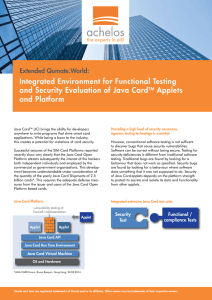
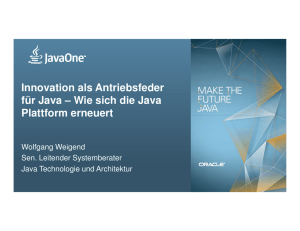
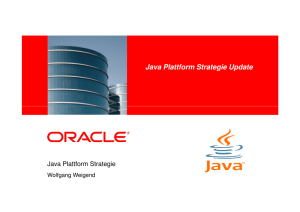
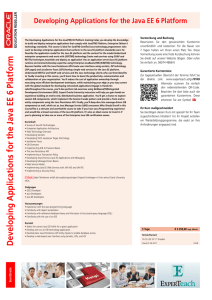
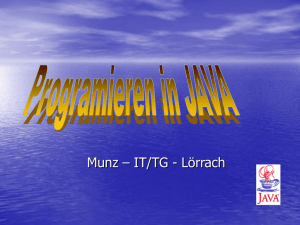
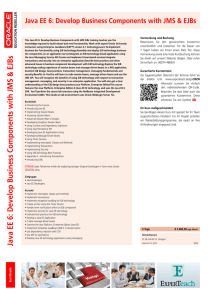
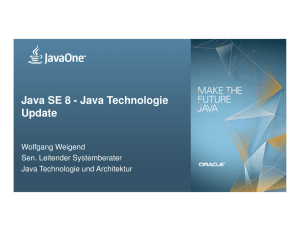
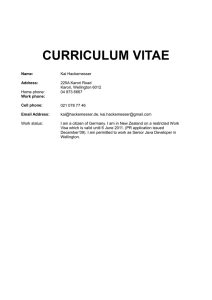
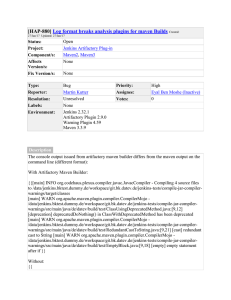
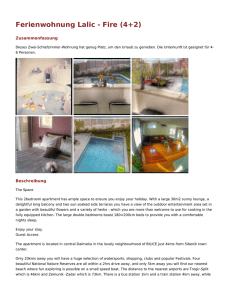
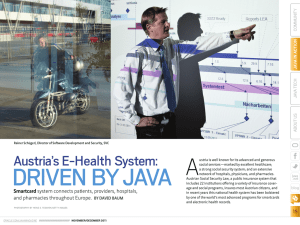
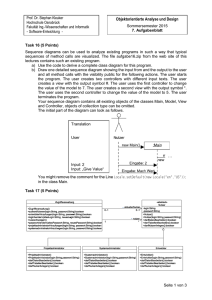


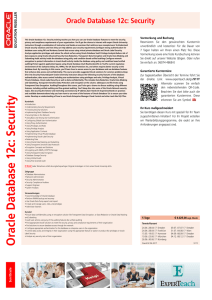
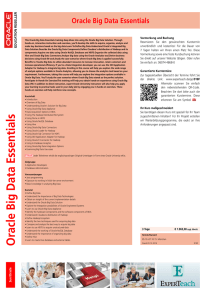
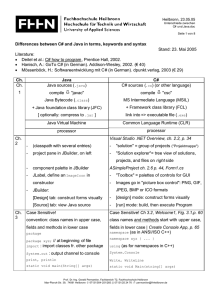
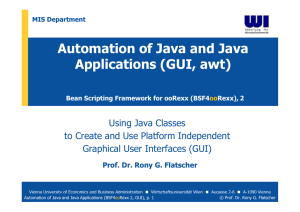
![[#BZANALYSIS-93] Simulating OpenWorkloads throws](http://s1.studylibde.com/store/data/005849429_1-b355c74cd8569694ecc2a4826cb2393e-300x300.png)

